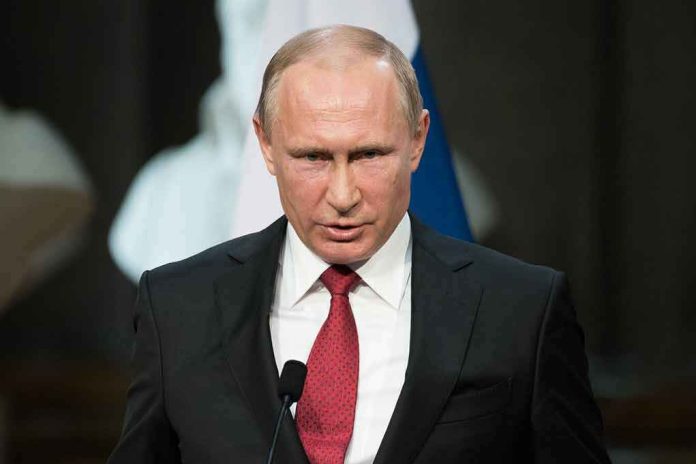
Putin’s relentless drive to capture the entire Donbas region represents a dangerous blueprint for territorial expansion that threatens not just Ukraine’s sovereignty, but the very foundation of international law and national self-determination that Americans have fought to defend for generations.
Story Overview
- Russia has pursued control of Donbas since 2014, escalating to full-scale invasion in 2022 with ongoing attempts to seize all of Donetsk and Luhansk oblasts
- Putin’s objectives combine strategic buffer zone creation against NATO, control of valuable industrial assets, and protection of Russian-speaking populations under false pretenses
- The conflict has produced severe humanitarian crises, massive displacement, and economic devastation while challenging Western resolve to defend sovereign nations
- Russia’s actions set dangerous precedents for authoritarian territorial revisionism that could embolden other aggressor nations globally
Strategic Buffer Against Western Integration
Putin’s primary motivation centers on preventing Ukraine’s integration with NATO and Western institutions, viewing Donbas as a critical buffer zone. Russia launched its full-scale invasion in February 2022 specifically to capture all of Donetsk and Luhansk oblasts, territories Moscow considers essential to weakening Ukraine’s sovereignty and maintaining Russian sphere of influence. The Kremlin frames this aggression as defensive, claiming protection of Russian speakers, but the reality reveals naked territorial ambition aimed at keeping Ukraine fragmented and vulnerable. This strategy directly undermines principles of national sovereignty that Americans understand as fundamental to international stability and peace.
Economic Exploitation of Industrial Heartland
Donbas serves as Ukraine’s industrial powerhouse, historically producing coal, steel, and heavy manufacturing critical to the nation’s economy. Russia seeks control over these valuable assets to integrate them into its own economic system while simultaneously depriving Ukraine of essential resources. The region’s infrastructure and production capacity represent billions in economic value that Putin wants to plunder. By seizing Donbas, Russia gains strategic industrial capabilities while crippling Ukraine’s economic viability, forcing greater dependence on Western aid. This calculated economic warfare demonstrates how authoritarian regimes exploit military force for financial gain, a pattern that threatens free market principles and property rights worldwide.
Historical Manipulation and False Narratives
The Kremlin justifies its aggression through distorted historical claims, exploiting Donbas’s demographic complexity shaped by Russian migration and Soviet-era russification policies. Despite Russian propaganda, Donbas maintains deep Ukrainian historical ties, including Cossack settlements and overwhelming support for Ukrainian independence in 1991 referendums. Russia’s 2014 annexation of Crimea established precedents for hybrid warfare tactics subsequently deployed in Donbas, where Moscow backed separatist uprisings to create puppet republics. These fabricated entities serve as cover for direct Russian military control. Putin’s narrative of protecting compatriots abroad mirrors dangerous historical patterns of authoritarian expansion that Americans recognize from past conflicts requiring decisive Western response to prevent further aggression.
Humanitarian Catastrophe and Regional Instability
Russia’s campaign has generated massive humanitarian crises, with widespread displacement, infrastructure destruction, and civilian casualties throughout Donbas. The conflict produces short-term devastation through active warfare while creating long-term consequences including demographic changes, economic collapse, and social polarization. Russian forces consolidate control over occupied territories through administrative integration and suppression of dissent, effectively erasing Ukrainian identity. The broader implications extend beyond Ukraine, disrupting European energy security, increasing regional defense spending, and challenging international norms against territorial conquest. This instability threatens American interests by emboldening other authoritarian regimes to pursue similar aggression, understanding that weak Western responses invite further challenges to the rules-based international order that has maintained relative peace since World War II. https://www.youtube.com/watch?v=Why Russia’s Putin Wants Ukraine’s Donbas, Will Trump Push
As fighting continues in late 2025, Russia maintains significant control over portions of Donetsk and Luhansk oblasts despite ongoing Ukrainian resistance supported by Western sanctions and military aid. The frontlines remain fluid as Moscow pursues full occupation while facing logistical challenges and determined opposition. President Trump’s administration now confronts critical decisions about American support for Ukrainian sovereignty versus potential accommodation of Russian territorial gains. The outcome will determine whether authoritarian aggression succeeds in redrawing borders through force, setting precedents that could encourage similar conflicts worldwide and undermine the national sovereignty principles Americans hold sacred.
Sources:
The Conflict in Ukraine’s Donbas: A Visual Explainer – Crisis Group
Crimea and Donbas – Ukraine Research Guide – UConn Library
Why Does Russia Want Donbas? 6 Things to Know – Kyiv Independent
The Russian Minority in Donbas and the History of the Majority – IWM
JSTOR: The Donbas Conflict – Scholarly Analysis





